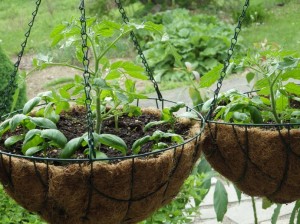 I’m not going to make any excuses for ‘being away’, but let’s just say that it’s been a miserable spring. Miserable weather-wise and miserable in many other ways which made me frankly not in the mood to share much of anything. But, I did keep things going in the greenhouse and once things finally warmed up here (which basically has only been in the last two weeks), we were able to get out into the garden and start putting things in. We had two massive frosts during this same period (I was starting to feel as if we were having weather whip-lash here) — literally going from the high 80s to the mid 20s — having to run out and cover up the berry bushes and spray the apple tree because the heat had pushed the tree to blossom all at once (spraying a fruit tree when it’s in blossom in the evening before a big frost will help protect the blossoms from being killed). And then, the next day, having to run out and uncover everything again the next morning. It’s been a crazy spring. (more…)
I’m not going to make any excuses for ‘being away’, but let’s just say that it’s been a miserable spring. Miserable weather-wise and miserable in many other ways which made me frankly not in the mood to share much of anything. But, I did keep things going in the greenhouse and once things finally warmed up here (which basically has only been in the last two weeks), we were able to get out into the garden and start putting things in. We had two massive frosts during this same period (I was starting to feel as if we were having weather whip-lash here) — literally going from the high 80s to the mid 20s — having to run out and cover up the berry bushes and spray the apple tree because the heat had pushed the tree to blossom all at once (spraying a fruit tree when it’s in blossom in the evening before a big frost will help protect the blossoms from being killed). And then, the next day, having to run out and uncover everything again the next morning. It’s been a crazy spring. (more…)
Raising It
Catching Up
Tomatoes UP!! Oh yeah, Baybee!
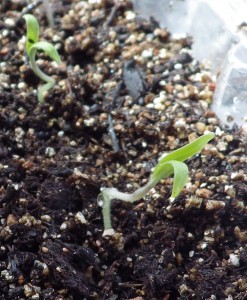 There is nothing like planting seeds and seeing them come up. Oh yeah!!
There is nothing like planting seeds and seeing them come up. Oh yeah!!
This tomato is a variety called Tumbling Tom and was developed specifically for hanging basket growing. Yes, even though here at Chez Siberia, we have certainly a big enough garden (though, ahem, I’m thinking we could use another couple of beds…a discussion for another time), I thought we’d try some hanging basket vegetable growing. We have a great, sunny deck which I usually use for hanging baskets of flowers, but who says that hanging basket veggies can’t be decorative too? We just have to make sure they get plenty of water (though I also have a plan to try out recycling baby disposable nappies – just the ones that got wet — as a way to keep moisture in the baskets). (more…)
Not too early to get ready for the garden
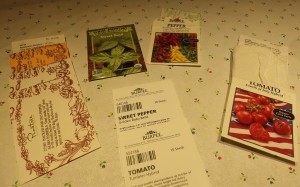 For folks in warmer places such as the US South and Southwest, this is rather late for you folks – I’m sure you have already gotten your seeds into the ground. But, in general, you can hold this information aside for this fall.
For folks in warmer places such as the US South and Southwest, this is rather late for you folks – I’m sure you have already gotten your seeds into the ground. But, in general, you can hold this information aside for this fall.
Where I live, our ‘frost-free growing season’ is pretty short: from Mid-May (and that is risky) through the end of September (and again, the last week in September will find a lot of us, 8 years out of 10, covering the tomatoes and peppers at night against frost). That’s less than 150 days and to get actual ripe veggies such as tomatoes and peppers, we can’t just throw seeds in the ground. That will not work. We need actual plants which will start flowering when the nights are warm (putting plants in the ground in May or early June which already have flowers open on them is really a waste – the plants will not ‘set’ fruit. For that, we need night-time temperatures that are at least 55 degrees F. So, we need to time the whole thing (as the Wicked Witch of the West in “The Wizard of Oz” put it) ‘very carefully’. We want the plants big enough to put into the ground (and the ground warm enough that they don’t get set back) but not so big that they already have flower buds on them. Dicey stuff. (more…)
Seeds! Seeds! They’re Here! They’re Here!!
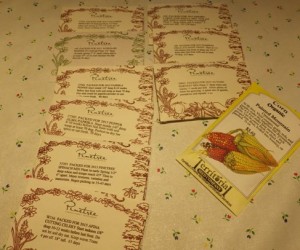 OK, that’s a lie. SOME of them are here.
OK, that’s a lie. SOME of them are here.
But not all of them.
And certainly the garlic and onion plants are not here; the garlic won’t arrive until this fall and the onion plants won’t arrive for at least a month.
But first, a message from our sponsor:
If you have not ordered your seeds, bulbs, sets, tubers, or whatever for your garden yet, then get to it, NOW. I ordered these several weeks ago and had to hunt and peck my way through the catalogs along with the web sites because some of the particular varieties were all sold out.
Don’t say you were not warned.
So, what is out there on the table that your Aunty is so excited about?
Afina Cutting Celery. What makes this sort of celery different from the usual sort that you buy in the grocery store? Well it sprouts more like a little bush and doesn’t form big chewy stalks. You can do this as ‘cut and come again.” It is much faster than celery, at 63 days.
Cucumber Ministro. One of my goals this time around was finding varieties which are super short season since the long-range weather boys have said that this summer will be cooler and drying here. This cucumber is 50 days.
Kohlrabi Winner We love eating kohlrabi fresh right out of the garden, sliced up. It makes wonderful coleslaw (or perhaps better spelled ‘kohl-slaw’). This one, like the cucumber above, is 50 days.
Spinach Mix One of the things, as I have noted before, about Pinetree Garden Seeds is that generally, you can find mixes of seeds, which is very nice if you are trying to grow a bed of something which will not all arrive at the same time. This one has spinach varieties which can be picked as early as 35 days. Woohoo!
Peppers One new project for this year is for us to create (or, ahem, try to create) our own paprika this year. Now, theoretically speaking, this should be simplicity itself: Get a lot of peppers which are red ripe, wash thoroughly, take out the seeds, dry, and run through the food processor or crush by hand with a motor and pestle. I picked two varieties which noted, right in the catalog, that they are to be used for paprika:
Alma Pepper (70 days)
Paprika (80 days)
For anyone wondering how ‘smoked paprika’ is made, you add the additional step of putting them in a smoker (many people have those as an attachment on their outdoor grill) once you’ve washed them and taken out the seeds, and smoke them until they are dry. To make sure they are really dry, I’d then run them through a dryer or in the oven on the pilot until they are breakable,
The other seeds are various varieties of ornamental corn, squashes, gourds and pumpkins, including the every-popular “Dill’s Atlantic Giant’. I must remind the DH to put in his reservation for the crane to come and pick up that one for the fair.!
So, what will you be growing this year?
Winter Gardening
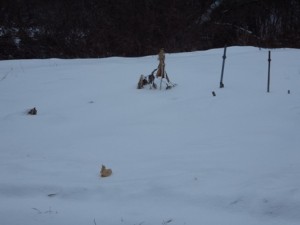 Hey, folks – welcome to February!! Up here at Chez Siberia, it’s doing its usual February thing, which means that from day to day, the morning temperature can range from minus 11 F. (which is -24C for folks across the pond) to 16 degrees F this morning (-9C). To say this sort of weather whiplash can be tough on plants is to put it mildly. As you can see from the photo, the garden at Chez Siberia is firmly under snow (though the depth is only 4-6 inches, really), and we’ve got (groundhogs notwithstanding) at least 6 weeks of snow and cold in front of us. If we get a break in March (which the long-range weather folk say we will), I’ll be able to shovel off a couple of beds in the garden, cover them with glass or clear plastic and warm them up enough (soil temps to 50 degrees F are plenty) to sow seeds from lettuce, beets, chard, and anything from the cabbage family. (more…)
Hey, folks – welcome to February!! Up here at Chez Siberia, it’s doing its usual February thing, which means that from day to day, the morning temperature can range from minus 11 F. (which is -24C for folks across the pond) to 16 degrees F this morning (-9C). To say this sort of weather whiplash can be tough on plants is to put it mildly. As you can see from the photo, the garden at Chez Siberia is firmly under snow (though the depth is only 4-6 inches, really), and we’ve got (groundhogs notwithstanding) at least 6 weeks of snow and cold in front of us. If we get a break in March (which the long-range weather folk say we will), I’ll be able to shovel off a couple of beds in the garden, cover them with glass or clear plastic and warm them up enough (soil temps to 50 degrees F are plenty) to sow seeds from lettuce, beets, chard, and anything from the cabbage family. (more…)
When choosing garden seeds, what information is most useful?
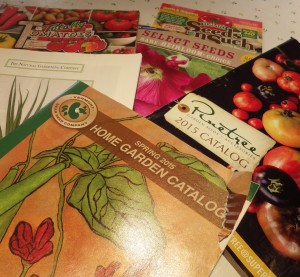 Good day, folks. I know you are veritably bristling with excitement over the upcoming gardening season, champing at the bit, so to speak. And, for the ‘old-timers’ out there, what I’m going to discuss today might seem old stuff, so you might as well go pour yourself a cup of tea, coffee or perhaps something stronger (hey, it’s been a really cold week here in the US – in Tampa, Florida, it was 36 degrees F at one point. The rest of us here in the northeast have had to sing praises when it hit positive numbers).
Good day, folks. I know you are veritably bristling with excitement over the upcoming gardening season, champing at the bit, so to speak. And, for the ‘old-timers’ out there, what I’m going to discuss today might seem old stuff, so you might as well go pour yourself a cup of tea, coffee or perhaps something stronger (hey, it’s been a really cold week here in the US – in Tampa, Florida, it was 36 degrees F at one point. The rest of us here in the northeast have had to sing praises when it hit positive numbers).
For the rest of you out there who are beginners or who have not been involved in vegetable gardening for very long, this, my little dear ones, is for YOU. (more…)
So, whatcha got?
Good afternoon, little munchkins. Now that you’ve theoretically crawled out from underneath the holiday wrapping paper and all the cookies, I’m sure what is burning at your brains is this:
What is new in the seed catalogs for 2015?
Yes, my plump little gardening elves, the seed catalogs have been out for a while; I swear the first one to hit my mailbox arrived the week after Thanksgiving. They are everywhere and I think they are all sharing their mailing lists as well since I’ve received some catalogs from companies that I’ve never heard from before.
However, I, your sweet old Auntie, have spent some of MY holiday time (a dirty job, but someone must do it) in checking out what is new. Not that I immediately rush to whatever new thing the seed folks are serving up (I do have my favorites, such as Royal Burgundy beans), but it’s always good to check things out because, after all…you…never…know.
Here are a few things that caught my eye. Not that there are not literally hundreds of new and newly-rediscovered varieties out there but here are a few that rang my bell:
Territorial Seed (Oregon): These folks, ever since I started buying a big block of onion plants which always do very well, have become one of our favorite sources. They have some very interesting things which might (depending on your point of view) be worth trying out:
Summer Purple
Summer Purple Broccoli. This does not form a big head (which is not a disadvantage in my book since you have to cut it up anyway) and, with a 60-90 day growing period looks to be something people could try out for early spring gardening, fall gardening and even, if you live in a relatively mild early winter area, winter gardening.
Quinoa
Quinoa. Yes, believe it or not, if you are interested in giving growing quinoa a shot, you can get seed here. Even if you live in a short-season area, it might be worth it to grow just for the nutritious greens.
Pinetree Garden Seeds (Maine): This seed house has been a long time favorite with us. In the early days it was because we could get small, relatively cheap packets of seeds. Since then they have grown on us because we can also get mixtures of seeds (such as mixtures of lettuces, or mixtures of peppers and so on), which is actually a lot more fun to grow.
Chia
Chia. This will take 4 months, and here in the north, will require starting just like tomatoes and about the same time, but if you’d like to give it a shot, here you go.
Celery
Peppermint Stick Celery. This looks good – fast to germinate and worthwhile growing because to be frank, grocery store celery is one of the top items on the ‘dirty dozen’ list of fruits and veggies which have high concentrations of pesticide residues. Grow your own.
Seed Savers Exchange (Iowa)
The grand-daddy of the heritage seed saving organizations.
Sorghum
Sorghum. Want to grow your own pancake flour? Shoot – want to grow your own pancake flour AND pancake syrup. Here you go. Long season – strictly for the south but definitely worth trying.
Hustard
Heirloom Mustard – the description says it is not prickly, which makes it a huge improvement on anything I’ve found. If you want to try mustard greens – here you go.
Johnny’s Selected Seeds (Vermont)
Gunsho
Gunsho (looks like Chinese asparagus to me), also referred to as choi sum. Great for stir fries and harvested for the tender stems and just-opening flowers.
Radish
Sora Radishes – The best feature here is heat tolerance so you won’t lose your radishes as soon as the first hot weather in the spring shows up.
Tiren Tomato
Tiren San Marzano. Great San Marzano tomato shape and flavor but earlier which is always a benefit.
So, check out the seed sites; open up those seed catalogs and put together your order, pronto.
What am I excited about this year? Cover crops – in specific, tillage radishes (which are really selections of daicon radishes which grow HUGE roots, pull up all sorts of nutrients in the soil and then…DIE, releasing all of that goodness into the upper reaches of the soil. Great stuff.
End of the season?
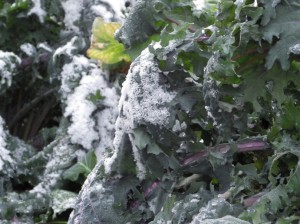 And a good, good day to everyone, wherever you are. This has been a very busy week in the garden for the DH and your Aunty. Not for choice necessarily, but sometimes you have to get things done before the weather gets colder, or rainier or something else (yes, what is on that kale is SNOW – it was 27 degrees F this morning. I think we can safely say that winter is coming).
And a good, good day to everyone, wherever you are. This has been a very busy week in the garden for the DH and your Aunty. Not for choice necessarily, but sometimes you have to get things done before the weather gets colder, or rainier or something else (yes, what is on that kale is SNOW – it was 27 degrees F this morning. I think we can safely say that winter is coming).
The big job that had to be taken care of was the arrival of the replacement fruit trees. Yes. Replacement. Not addition. Replacement, as in ‘Dear Sir, the fruit trees x.y.z etc. that I ordered from you did not grow. As a matter of fact, they died. Toes up. Kicked the bucket. Gone to meet their maker. Please send replacements. Respectfully…” It happens, and if you don’t know this first thing in the spring (which most people don’t because you are waiting, hopefully, that the damned things will leaf out and oh, joy!!
Only these ones did not. (more…)
OK, so you’ve got a garden – what are you going to do with it?
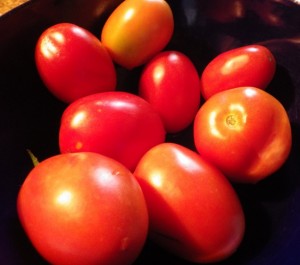 OK, so here we are, at what, for us here at Chez Siberia, is well on the way to the prime production time out there in the garden. And frankly, even though we’ve been doing this for (ahem) 35 years, we, too get the shakes when we look out there (and our garden is not that big, truly, folks) and see all that stuff that has somehow been produced through seeds, sun, and water.
OK, so here we are, at what, for us here at Chez Siberia, is well on the way to the prime production time out there in the garden. And frankly, even though we’ve been doing this for (ahem) 35 years, we, too get the shakes when we look out there (and our garden is not that big, truly, folks) and see all that stuff that has somehow been produced through seeds, sun, and water.
It’s humbling, truly. (more…)
Cue the scary music
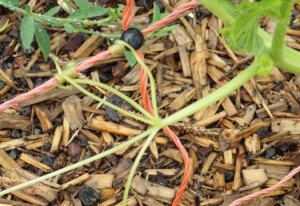 I am sure a lot of readers here have seen a photo that is out there on the ‘net’ showing a huge boulder with a tree growing right up through the center of it as an illustration of ‘paper beats rock’ or something like that.
I am sure a lot of readers here have seen a photo that is out there on the ‘net’ showing a huge boulder with a tree growing right up through the center of it as an illustration of ‘paper beats rock’ or something like that.
But in the garden (or at least the gardens that most of us have), we are not dealing with a tree growing up through a rock. We are dealing with vegetables that, pound for pound are probably stronger than we are. I point out the photo at the top. That, my friends, is a tendril from a vine of (deh-duh) a spaghetti squash. I love spaghetti squash; I truly do. But the vines all by themselves are aggressive and voracious, running all over the place in a garden, climbing out, hitting the streets. so far, the only way we’ve been able to keep them under control is with a lawn mower.
Truly.
This year, because we put out electro-net fencing to keep out the bunnies (and we’ll see how well this works; I’m thinking the openings are too big for bunnies. They might work with a rather rotund woodchuck, but I’m thinking a bunny is going to have no issues with it, frankly), the spaghetti squash vines have made a break for it by attaching themselves to the electro-netting. And wrapping themselves around it with those tendrils. Look closely; those thing don’t just snag on the netting; they are wrapped around in corkscrew fashion. A few more of those and I anticipate seeing that fencing laying flat on the ground and waving a white flag. (more…)
